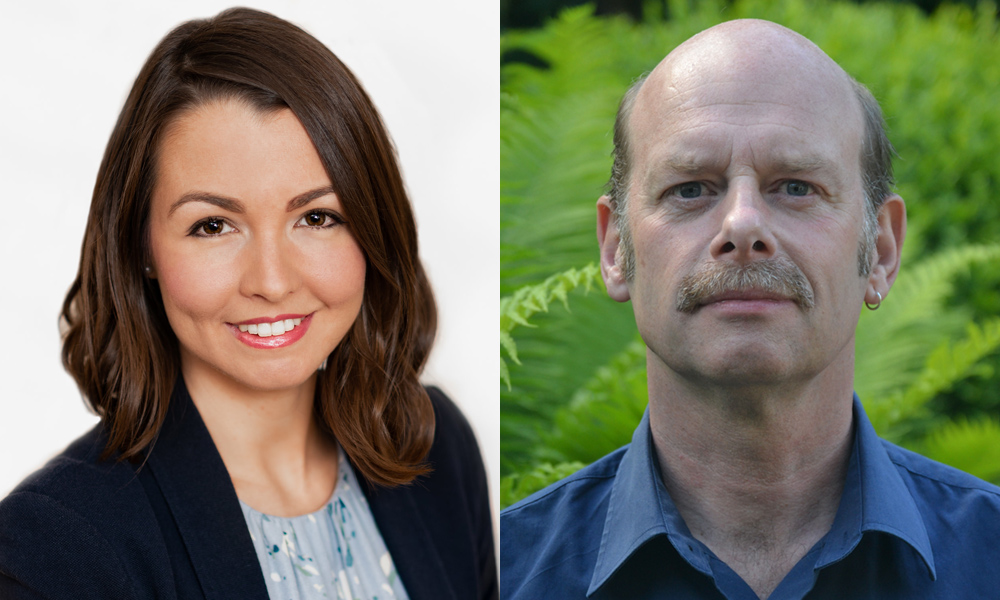
Read the latest Issue
Committee recognises outstanding contributions of EMBL alumni to science journalism and genome editing

The winners of the 2020 EMBL Alumni Awards have been selected. Giorgia Guglielmi wins the John Kendrew Award for her journalism work focusing on the intersection of science and society, while John van der Oost wins the Lennart Philipson Award for his contributions to our understanding of the genome editing tool known as CRISPR–Cas. The awards will be presented as part of the EMBL World Alumni Day celebrations, which will be live-streamed on 17 July. Here, the awardees discuss some of the defining moments in their careers.
Giorgia Guglielmi has always been fascinated by how an embryo develops into a mature organism. In 2011, she joined the group of Stefano De Renzis at EMBL Heidelberg to investigate embryonic development. For her PhD research, Giorgia worked with an experimental tool that uses laser light to evoke changes in cell behaviour. “Nobody had used this technique before to understand how cells behave in a whole organism during development,” Giorgia recalls. “When we published our results, researchers immediately started asking for help to do this themselves.”
Besides her passion for science, Giorgia felt a strong interest in communication throughout her studies. “In high school, my dream was to become a journalist. Then I fell in love with science,” she says. “It was at EMBL that I realised I could combine my passions.” She started writing articles for EMBL’s news website and found that science communication was her true calling. In 2016, having earned her PhD, she applied successfully for a spot in MIT’s prestigious Graduate Program in Science Writing. In the thesis she wrote as part of the course, Giorgia investigated how misinformation had led to the death of millions of olive trees in the Italian region of Apulia, where she was born. “I travelled to Italy, interviewed scientists, conspiracy theorists, government officials, and farmers, and had to balance all the information with creativity and style in writing,” she explains. “That was a huge effort.”
The hard work paid off. Giorgia’s report won her an MIT Stanley Klein Prize for Scientific Writing. After graduating from MIT in 2017, she had the opportunity to work in the newsrooms of Science and Nature. “There I realised that I really like being a science journalist,” she says. “We get to cover the most exciting and important topics of the day.”
Covering the societal aspects of scientific research is at the heart of Giorgia’s work. She wrote about alleged irregularities in a homeopathy study that was later retracted, and reported about a donation from the Italian National Order of Biologists (ONB) to a group that questions the safety of vaccines. The donation has since been withdrawn. “This kind of work can be stressful, but it’s very satisfying to see that my stories are read by thousands of people, and that they sometimes even influence science policy,” says Giorgia. She now works as a freelance science journalist in Cambridge, Massachusetts. Her writing has recently focused on diversity, exploring gender imbalances in science and the under-representation of indigenous populations and other marginalised groups in genomic studies.
Looking back, Giorgia believes that her scientific training prepared her well for working as a science journalist. “As a scientist, I’m equipped with the skills to look for evidence and base my conclusions on facts,” she explains. “Stefano and my mentors at MIT have always supported me, and at Nature and Science I got to work with great editors and reporters.” Giorgia sees receiving the John Kendrew Award as a signal that rigorous science communication is important and valued. “I’m grateful to the committee for supporting independent science journalism. That’s a huge encouragement for me to keep going.”
John van der Oost has spent most of his scientific career studying bacterial enzymes. Having obtained his PhD from Vrije Universiteit (VU) Amsterdam, he joined the lab of structural biologist Matti Saraste at the University of Helsinki. Shortly afterwards, he moved with Matti to EMBL Heidelberg. “I had never seen such an international, well-organised, and stimulating research environment,” John recalls. After returning to VU Amsterdam for a postdoc position, he started his own research group at the University of Wageningen, also in the Netherlands.
While studying Sulfolobus, a microorganism that lives in extreme environments such as hot springs, John and his team discovered unexpected stretches of repetitive DNA among its genes. The finding became a side note and was not investigated further. Several years later, Eugene Koonin from the National Center for Biotechnology Information in Bethesda, Maryland, visited Wageningen. The seminar he gave during his visit got John thinking again about the stretches of bacterial DNA. These DNA regions appeared to contain fragments of viral DNA, an adaptive defence system against bacteriophages – viruses that infect bacteria. John had stumbled upon the system now known as CRISPR–Cas: a powerful genome editing tool that biologists can use to target a specific DNA region.
“I had just received a major grant, so I decided to use part of the money to study CRISPR,” John explains. In the years that followed, he and his team made a series of seminal discoveries that explain how the CRISPR–Cas system works. The researchers were able to show that CRISPR-derived small RNA molecules are used as guides to target DNA, and not RNA as initially assumed. They also figured out the roles of CRISPR-associated enzymes called Cas nucleases: specialised proteins that are targeted to a specific DNA sequence by the CRISPR RNA and cut the DNA at that point – a powerful method to destroy bacteriophage DNA. Most importantly, John and his colleagues managed to transplant the entire CRISPR–Cas system to another bacterial strain and succeeded in programming it to protect the recipient bacteria against a specific bacteriophage – a ‘flu shot for bacteria’.
With these results, John had found the key ingredients to enable genome editing applications. The results were published in 2008, and – after some further insights were revealed – a patent was filed in 2011. However, John’s CRISPR–Cas system required the activity of six Cas proteins. “Half a year later, the teams of Virgis Šikšnys, Jennifer Doudna, and Emmanuelle Charpentier caught up with us,” John recalls. “They used the Cas9 protein, which combines all the functionalities in a single protein, so it’s much easier to work with.” It took John and colleagues another eight years to optimise their system to work in human cells, but they finally succeeded in 2019.
Meanwhile, John has continued to explore bacterial genome editing mechanisms. “My group is bigger than ever, and 10 to 15 people in the lab are working on several CRISPR-related systems. We characterise and optimise new and existing systems and design applications, mainly in microorganisms,” he says. The potential applications are manifold. CRISPR has already revolutionised life science research and is likely to have a similar impact on biotechnology and health care.
Reflecting on his career, John points out the huge impact that chance and unexpected developments have played. “I could never have predicted that I would end up where I am now, and I think very few people can really plan far into the future. It’s a matter of keeping your eyes open and looking for opportunities. But I think this uncertainty is also what makes science one big adventure.”
Nominations and applications for the 2021 John Kendrew and Lennart Philipson Awards are now open. Please click here to find out more and submit a nomination or application.
Looking for past print editions of EMBLetc.? Browse our archive, going back 20 years.
EMBLetc. archive